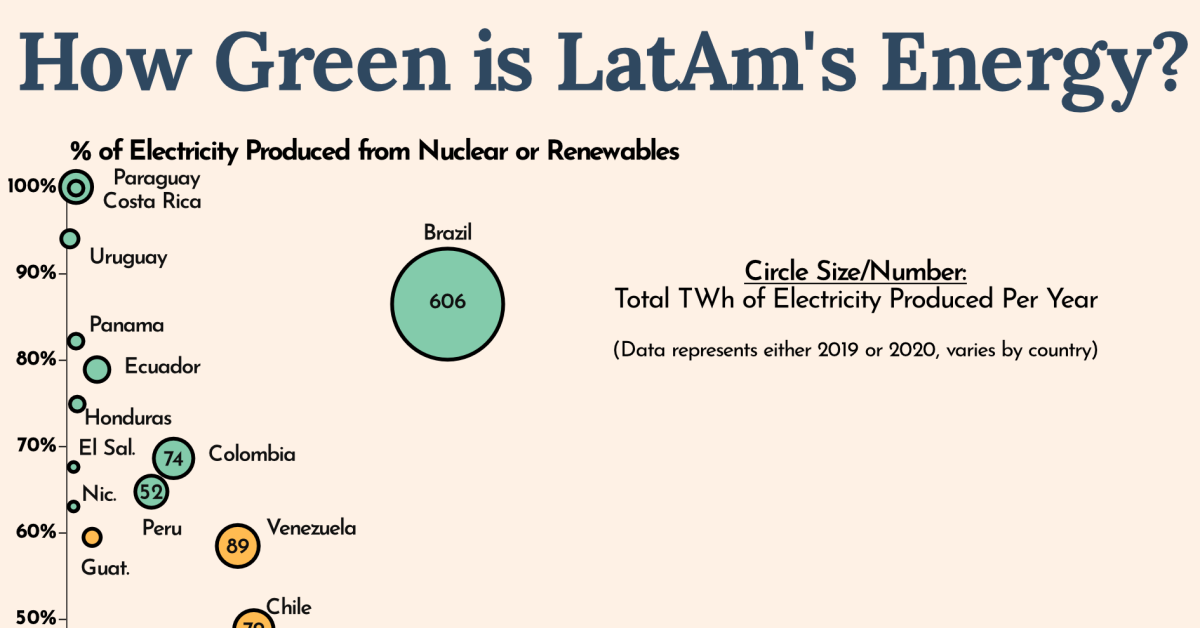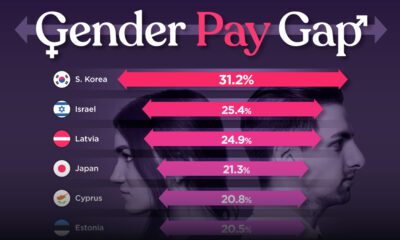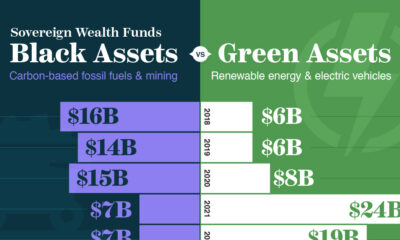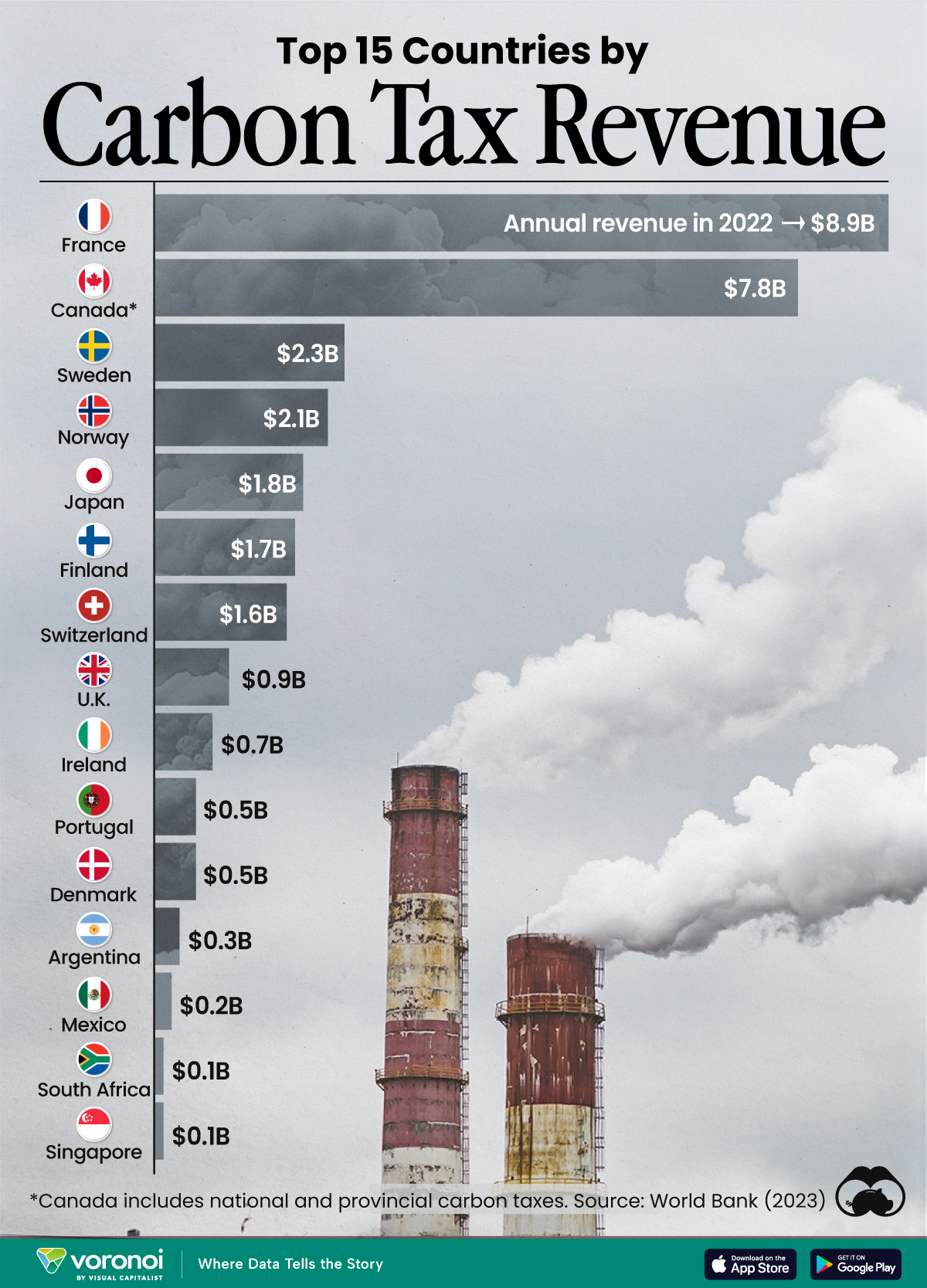Green
Ranked: Latin American Countries By Green Energy Use
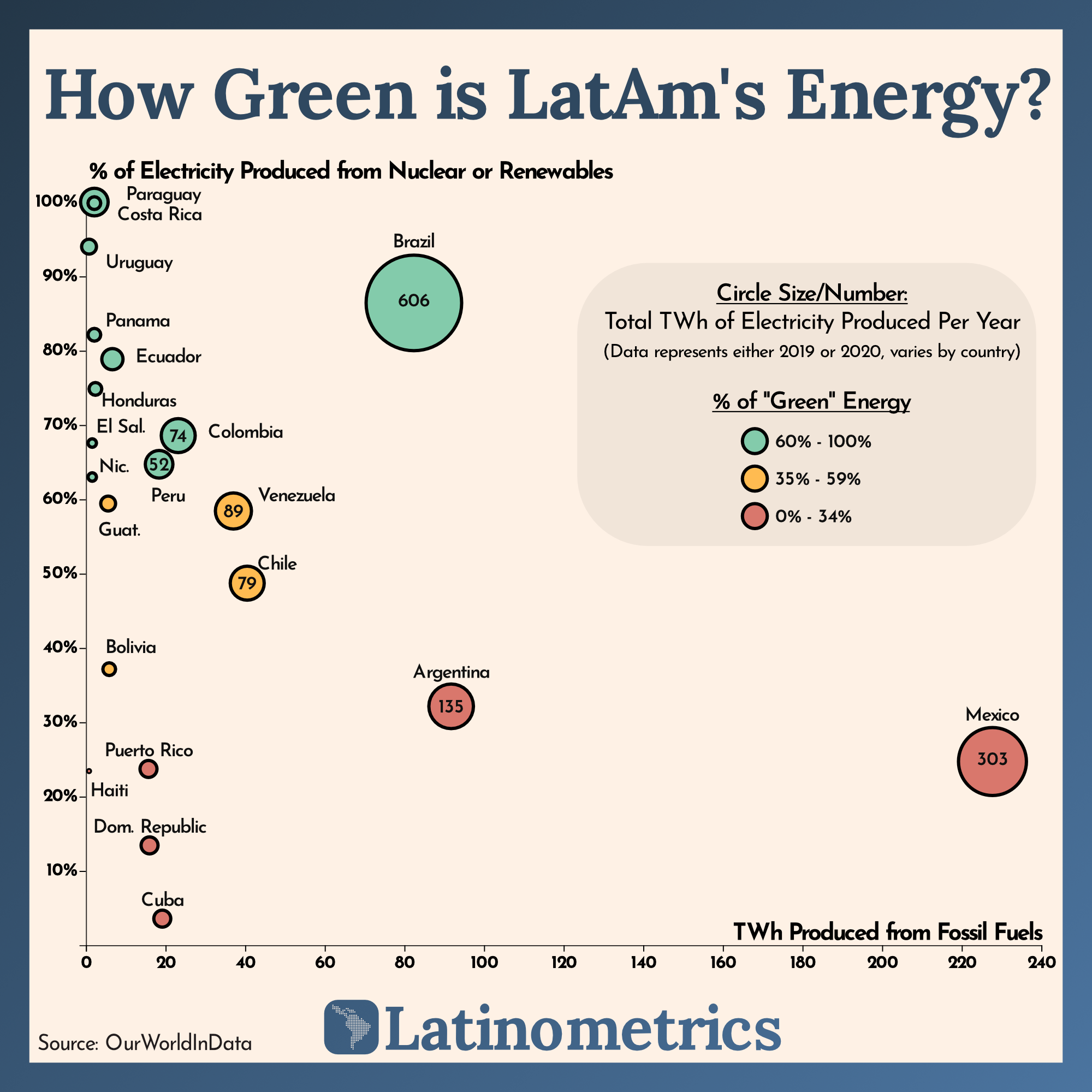
Ranked: Latin American Countries By Green Energy Use
The global push for increasing green energy use is well underway, as countries around the world are feeling pressure to revamp their climate-impacting practices.
But with different populations, energy use requirements, and access to natural resources, certain regions will have a more significant role to play. With a population of 664 million and an abundance of natural resources, Latin America (LatAm) is one such region.
How green is LatAm’s energy today? This graphic from Latinometrics charts countries’ electricity production from renewables relative to fossil fuels and highlights the significant disparities between certain nations.
Green Energy Use in Latin America
As of 2020, many LatAm countries actually produced 50% or more of their electricity from renewable sources including nuclear energy. Let’s take a deeper look at some of the outliers:
Paraguay
Hydropower is Paraguay’s primary renewable energy source, and plentiful. In fact, the country produces surplus electricity and exports the remainder to Argentina and Brazil. Altogether, 60% of Paraguay’s hydroelectric power is exported, contributing to 6% of its GDP.
The primary resource for this hydropower—the Itaipú Dam—sits between Paraguay and Brazil and is jointly owned by both. The dam is responsible for 79% of Paraguay’s total power capacity.
Costa Rica
Costa Rica has been running on at least 98% renewable energy since 2014. Both within the Americas and on a global scale, the country’s green energy usage ranks extremely high, primarily driven by hydropower:
| Costa Rica's Renewable Energy Sources | % of Renewable Energy (2019) |
|---|---|
| Hydropower | 67.5% |
| Wind power | 17.0% |
| Geothermal power | 13.5% |
| Backup plants | 1.16% |
| Solar panels | 0.84% |
But notably, Costa Rica’s volcanoes are also utilized as a source of geothermal power.
Mexico
Mexico ranks considerably lower on the green energy spectrum. The country produces 303 TWh (Terrawatt hours) of electricity a year, but over two-thirds comes from fossil fuel sources.
Lately, intense political discussions within Mexico have emerged regarding energy policies. The country has attractive solar energy potential, with some of the greatest levels of sunlight globally, but has yet to fully tap into this renewable source. Recent actions from the current administration is reversing prior decisions towards renewables and is prioritizing domestic coal production, whilst enabling anti-competitive practices for state-owned entities.
Based on current assessments by energy analysts, Mexico may see increases in carbon emissions in the decades to come.
Brazil
Brazil is Latin America’s largest economy and the 12th largest in the world, with a GDP of about $1.5 trillion. Its oil industry remains a crucial component of the economy and ranks 9th in the world by output—producing roughly 3.2 million barrels a day.
While this may suggest Brazil relies heavily on fossil fuels, the country’s electricity production from green energy actually ranks extremely high. Of Brazil’s 606 TWh of electricity produced per year, 86% comes from nuclear or renewable sources.
Given its size and strength, Brazil is positioned to act as a leader within the continent on the path to net-zero. In 2021, Brazil dedicated $12 billion in investments towards energy transitions, putting it in the top 10 countries by spending.
Argentina
Relative to its more green-energy friendly neighbors, Argentina is falling behind on its renewable energy efforts. It produces 135 TWh of electricity per year, but only around 30% comes from nuclear or renewable energy.
Extended periods of economic instability are a driving cause, which are constantly shifting the country’s priorities elsewhere. Some years ago, it launched the Argentina Renewable Energy Auction program to try and improve renewable electricity production by 2025, but many projects were scrapped due to financing issues.
However, southern Argentina is a particularly windy region within Latin America, making it a desirable spot for future wind power generation and investment.
How LatAm Compares on a Global Scale
More than a quarter of LatAm’s energy comes from renewable energy, double the global average.
While countries around the world are striving for renewable energy to make up half or more of electricity generation by 2050, nearly two-thirds of LatAm countries have already done so. Additionally, Paraguay is one of only seven countries in the world to derive 100% of its electricity production from green energy.
How will other countries by influenced by Latin America’s green energy leaders in the years to come, and how will the region’s green energy usage evolve?

This article was published as a part of Visual Capitalist's Creator Program, which features data-driven visuals from some of our favorite Creators around the world.
Green
Ranking the Top 15 Countries by Carbon Tax Revenue
This graphic highlights France and Canada as the global leaders when it comes to generating carbon tax revenue.
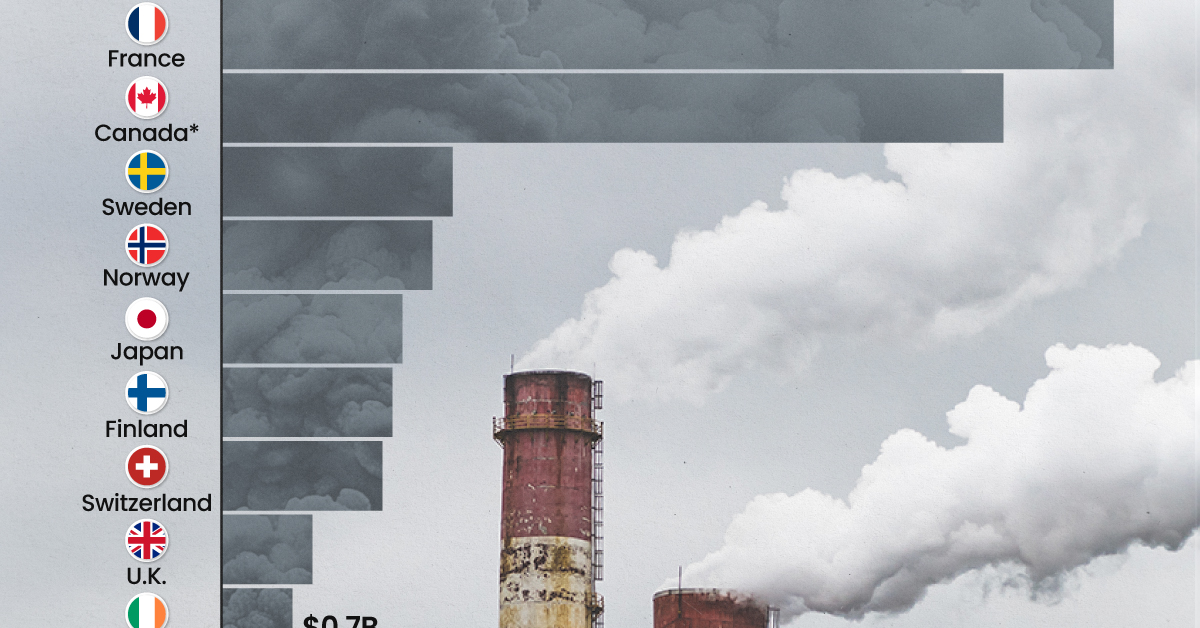
Top 15 Countries by Carbon Tax Revenue
This was originally posted on our Voronoi app. Download the app for free on iOS or Android and discover incredible data-driven charts from a variety of trusted sources.
Carbon taxes are designed to discourage CO2 emissions by increasing the cost of carbon-intensive activities and incentivizing the adoption of cleaner energy alternatives.
In this graphic we list the top 15 countries by carbon tax revenue as of 2022. The data is from the World Bank’s State and Trends of Carbon Pricing Report, published in April 2023.
France and Canada Lead in Global Carbon Tax Revenue
In 2022, the top 15 countries generated approximately $30 billion in revenue from carbon taxes.
France and Canada lead in this regard, accounting for over half of the total amount. Both countries have implemented comprehensive carbon pricing systems that cover a wide range of sectors, including transportation and industry, and they have set relatively high carbon tax rates.
| Country | Government revenue in 2022 ($ billions) |
|---|---|
| 🇫🇷 France | $8.9 |
| 🇨🇦 Canada | $7.8 |
| 🇸🇪 Sweden | $2.3 |
| 🇳🇴 Norway | $2.1 |
| 🇯🇵 Japan | $1.8 |
| 🇫🇮 Finland | $1.7 |
| 🇨🇭 Switzerland | $1.6 |
| 🇬🇧 United Kingdom | $0.9 |
| 🇮🇪 Ireland | $0.7 |
| 🇩🇰 Denmark | $0.5 |
| 🇵🇹 Portugal | $0.5 |
| 🇦🇷 Argentina | $0.3 |
| 🇲🇽 Mexico | $0.2 |
| 🇸🇬 Singapore | $0.1 |
| 🇿🇦 South Africa | $0.1 |
In Canada, the total carbon tax revenue includes both national and provincial taxes.
While carbon pricing has been recognized internationally as one of the more efficient mechanisms for reducing CO2 emissions, research is divided over what the global average carbon price should be to achieve the goals of the Paris Climate Agreement, which aims to limit global warming to 1.5–2°C by 2100 relative to pre-industrial levels.
A recent study has shown that carbon pricing must be supported by other policy measures and innovations. According to a report from Queen’s University, there is no feasible carbon pricing scenario that is high enough to limit emissions sufficiently to achieve anything below 2.4°C warming on its own.
-

 Green2 weeks ago
Green2 weeks agoRanked: Top Countries by Total Forest Loss Since 2001
-

 Travel1 week ago
Travel1 week agoRanked: The World’s Top Flight Routes, by Revenue
-

 Technology2 weeks ago
Technology2 weeks agoRanked: Semiconductor Companies by Industry Revenue Share
-

 Money2 weeks ago
Money2 weeks agoWhich States Have the Highest Minimum Wage in America?
-

 Real Estate2 weeks ago
Real Estate2 weeks agoRanked: The Most Valuable Housing Markets in America
-

 Markets2 weeks ago
Markets2 weeks agoCharted: Big Four Market Share by S&P 500 Audits
-

 AI2 weeks ago
AI2 weeks agoThe Stock Performance of U.S. Chipmakers So Far in 2024
-

 Automotive2 weeks ago
Automotive2 weeks agoAlmost Every EV Stock is Down After Q1 2024

